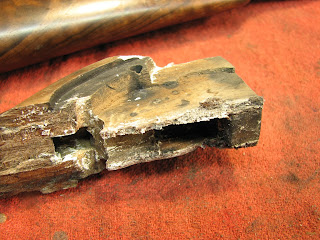I think I'll call it "Stupid Shit You Read On Gun Forums".
Internet forums, and gun forums in particular, continue to prove the validity of Dunning and Kruger's studies. They remain places where people who couldn't find their own ass using both hands spout "expertise" on subjects about which they know little to nothing.
Our first installment concerns hinge pins and barrel hooks. The apparent conventional "wisdom" is that the hook is what wears, never the pin, because the pin is "hardened" and the hook "is not". This "wisdom" disregards the fact that the hook is not made of the same material as the hinge pin, and, that the "hardening" of the hinge pin is usually of negligible value.
Part and parcel of this wisdom, is the idea that replacing the hinge pin in order to correct an off-face condition is hogwash: "Just weld up the hook and refit" (usually with a Dremel) is the correct course of action, according to the terminally ignorant. How does one weld up the hook of a Model 21 when it's off the face (sorry fan-boys, it does happen)? What about welding the hook of chopper lump barrels (which have a braze seam running right down the center of the lump)? I have seen both of the above examples welded by gun plumbers, both American and English, and it's not pretty.
The hinge pin in most break action guns is made of the same (or similar) material as the frame in which it resides. That material is a low-carbon (sometimes very low), plain steel. These steels are non-hardenable on their own due to their low carbon content and so are (in this application) surface hardened (case hardened). Without getting into a long-winded dissertation on the subject, case hardening is a process whereby extra carbon is added to the steel at the surface and, to an extent, below the surface. This makes the surface effectively hardenable. Case hardening consists of numerous steps, the first (assuming a virgin part) is carburizing, wherein the carbon is added to the surface via a combination of heat and an external carbon source. The second step is the actual hardening, which consists of heating and quenching the part, so as to transform the now more carbon-rich surface (the steel below the surface remains unhardened) and the third step (usually ignored by gun manufacturers) is tempering of the part. Depending upon certain variables, the hard "case" that forms on the part can be relatively deep (.060" or more).
Gun manufacturers, for reasons unknown to me, tend to skip the individual first carburizing step and combine it with the hardening step. While this does save time, it also results in a much thinner "case". The hard surface on a frame rarely exceeds a few thousandths, often being .005" or less, usually much, much less. This seems to be because case hardening is used in the gun world as more of an ornamental "finish" than a functional surface treatment. Now, with a hard skin that thin, one might surmise that the soft steel below would be free to deform just as easily as without the hardened layer. One would be correct. Once the very thin hardened layer wears off (or through), wear accelerates rapidly. This is especially true in American doubles because the vast majority of those use the hinge pin as a structural element, meaning it reacts the forces generated upon firing, rather than being only a pivot around which the barrels rotate to open or close. In simpler terms, when these guns are fired, the hinge pin is what keeps the frame from departing to the rear. When the gun is fired, the hinge experiences the same force that the breechface does, but in the opposite direction and over a much smaller area. This force is also offset to one side or the other, depending upon whether it is the right or left barrel that is fired, causing the barrels to try and yaw about the hinge. This causes deflection/deformation of the pin, which accelerates wear of the very thin hard skin, because the hard skin is much less flexible than the steel beneath.
The fact is that the internet experts are wrong, again, as usual. In American designs it IS usually the pin that wears and replacing the pin IS the only correct remedy. Now, correct means different things to different people but I prefer the dictionary's definition of most words. Below are examples from this very blog that illustrate the point. I've done many, many more prior to starting the blog and on guns that simply were not interesting enough to make it here. Also, contrary to what the "experts" say, a new hinge pin, when done properly, does not "stick out like a sore thumb". They are, in fact, indistinguishable from original.
Ithaca NID
Barovnik
L.C. Smith
Fox SBT
Fox Sterlingworth
Now, given that the hinge pin is worn, and the worn area is almost never a perfect arc, how does one weld and refit the barrel hook so that it maintains full contact while traveling around the worn pin? Answer: It can't be done.
































